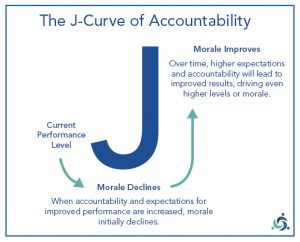Executive Coaching, Leading Change
7 Deadliest Words of Change… Strategies to Avoid getting Roadblocked
“We’ve never done it that way before.” Nothing cripples change and innovation faster than these 7 little words, and the mindset of the person who spoke them. The individuals pointing out the obvious are, in fact, usually correct. If it’s a change, chances are it hasn’t been done in that way either by the company or the team. Change is uncomfortable, and hesitation is to be expected. When that sentence is used to justify why change shouldn’t happen, however, you’ve got a problem.
“If you keep on doing what you’ve always done, you will keep on getting what you’ve always got.”
As a leader, it is your job to successfully lead and implement the changes needed to keep your team and organization moving forward. One of the common obstacles in your way is often a team member (or a couple) balking at the change. (I’ve written more about why employees resist change here). The following 9 tips will help you overcome the attitude and actions roadblocking your efforts to effectively implement changes and lead innovation.
Acknowledge that these words are accurate
Some people love to point out that not all change is good change. They’re right, and there are countless historical examples to back it up. But I can also confidently point out that good change can’t happen in your personal or professional life without, well, change. Leadership is all about improving the condition of those we lead. We cannot lead ourselves or our teams to something better without a willingness to embrace change and strive for the results we envision.
Create a positive vision of the change
Provide your team with a positive, compelling, and inspiring vision of the outcome, and commit to it fully through your words and actions. If you, as the leader, can’t visualize a positive outcome for the implementation of the change, how can you expect your direct reports to see the change as positive.
Sell Problems, Not Solutions
Telling people that we need to improve the levels of service provided to customers is a great example of selling people on the solution instead of the problem. People have a much harder time buying into solutions they were not a part of creating. Obtain employee buy-in to a change by selling your team on the problem:
- Present the problem – If we don’t improve our website, is it possible that our customers will find a company with a better website?
- Ask for input – How do you recommend we improve our website?
People tend to like their solutions a lot better than yours. Steer the direction but allow your team members to be an active part of the solution process.
Rethink Possible
I’ve worked with countless leaders who confidently informed me that the proposed change would not work. Or they tailor their statement to their circumstances by telling me, “That won’t work here.” I don’t know about you, but when someone tells me something can’t be done, I’m that much more motivated to prove them wrong. In today’s world, there isn’t much that isn’t possible. Some things may be impossible today, but someone, somewhere, will eventually figure out how to make it possible. That “someone” can’t be your team or organization if you’re working with the belief that it’s impossible.
Involve Them in Developing a Plan
People don’t dislike change as much as they dislike being changed. Take the time to involve the people who will be responsible for implementing the change… even your most difficult and resistant employees.
Honor the Past, Build a Bridge to the Future
When new managers come into an organization, some have a need to tell everyone how good the organization they came from really was and how they intend to fix all the shortcomings of their new team. Employees understandably resist this approach, as they do a heavy-handed and brazen approach to organizational change. When it comes to leading innovation and change, this strategy has a high chance of backfiring. When team members hear their established and comfortable ways of doing things are changing, they will dig their heels in to protect how things were done in the past. Instead of forcing the change on your reluctant team members, acknowledge and honor the past, and then lead a discussion about what a new vision with even better results could look like.
Focus on Results
When it comes to significant change, leaders can get sidetracked by their focus on and concern for how team members feel. Most people do not feel excited and positive when they are being asked to make significant changes to how they do work, or the amount of work you are asking them to do. To focus solely on morale at this point is a mistake. Focus instead on the results you are trying to achieve through the implementation of the change. When people achieve positive results and the team is in alignment with the future of the organization, morale will take care of itself.
Remember the “J” Curve
Whenever a change is made, there’s a good chance that things will get worse before they get better. It’s what I refer to as riding the “J” curve of change.

When you begin to hold employees accountable for implementing a change, remember that morale and productivity may go down before it comes back up and rises to an even higher level. When you start implementing a change and hold employees accountable for the results, some employees may become resentful. Remember the J curve and keep pushing forward.
Move Fast
Research tells us that fast change is easier for an employee to deal with than slow change. Some organizations can implement a change in 24 hours. Other organizations take years to implement the same change. If you think employees enjoy slow change, put a Band-Aid on the hairiest part of your arm and pull it off… slowly, one hair at a time. It won’t take long before ripping the Band-Aid off quickly will be your preferred course of action. Consider how much time you have to implement your change and stick to the time frame if you want to remain a competitive force in the marketplace.
Being a great leader in search of the path that leads to workplace excellence is not for the faint of heart. You will run into plenty of “We’ve never done it that way before” and “It won’t work here.” Next time you’re faced with these responses, get excited. You have the tools to handle it, and you’re ready to take on the challenge of implementing change that will take you, your team, and your organization to the next level.











Leave a reply